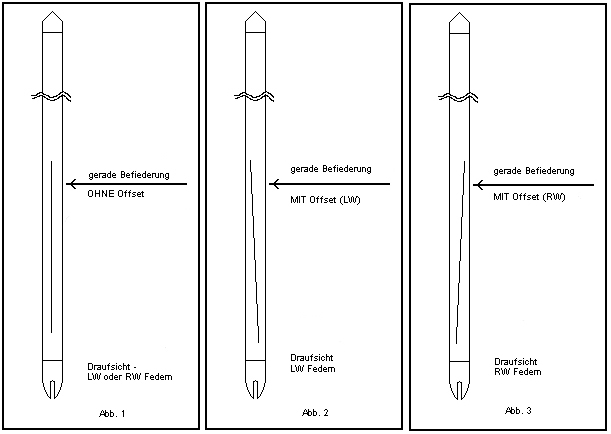As part of our project " shooting war" we have prepared a lot of bamboo arrows, and feathered. In Kyudo arrows are usually feathered and straight without twist or offset. The springs are different chord than the European Archery usual.
are, however, was also in Japan and Asia, other types of fletching quite common and widespread.
We remember an arrow turns to the launch, due to the nature of the spring (left or right) about its own axis, thereby stabilizing its flight. In a straight fletching this takes much longer than with a twist or offset Fletching. The spin-stabilized fletching the arrow much faster, but costs and speed is at about 40 m clear shots of a disadvantage.
However, it may be appropriate that an arrow stabilized quickly. For example, in hunting, there are shot at relatively short distances and the arrow will fly as fast very stable. But drain error, so errors in technique will be corrected by a Drallbefiederung or by an offset. This can be in fast shooting on the hunt, but also the stress of a race, as with the quick war shooting of use.
achieved with an offset to weaker rotation of the arrow as a Drallbefiederung, because in the latter the spring is wound in addition to.
Why turn to an arrow has two other reasons. For one thing, each arrow shaft small errors that affect its flight slightly. This is especially true with bamboo or wooden arrows, but also with "older" Alupfeilen. If the arrow does not rotate, this error would be increased over the course of the flight so that the arrow is very different from its flight path. Turning to the arrow, the error is corrected at every turn again. Also holds a rotating arrow, the tip in one direction, namely toward the goal. This is an important factor when you consider that an arrow, a rotation speed of 1,200 can have up to 2,500 revolutions per minute.
As everyone now feathered his arrow shall be his thing, and whether it offsets its technical shortcomings with these little tricks, too. But here the technical background of the various Befiederungsarten.
We basically distinguish between left-wing (LW) and right (RW) springs. In Kyudo Haya (RW) and Otoya (LW).
The two figures can be seen very nice, as the springs are tendon. In the Japanese archery is the "Leitfeder" in one axis to the chord. In the European (western) Archery is the Leitfeder 90 to see added.
What about the different concepts of "spin-feathering" and "offset" means. Here are some pictures that illustrate what it is meant.
The respective pen type (LW or RW) determines which direction of twist or offset direction is possible. Thus, the direction of the arrow will rotate after launch. should be fletch
To arrows in this way can also use the right tool. I prefer the "Jo-Jan-6-fletching jig. First, because I can edit the same sets of 6 arrows at once, partly because even long springs for Kyudo arrows can be processed so good. However, the offset can be adjusted easily. Especially important is the fact that I can replace this device Nockaufnahmen. So I can fletch "Western" arrows and a separate set Nockaufnahmen also Kyudo arrows. In addition I have rebuilt a set of six Nockaufnahmen.
 |
| The Jo-Jan fletching jig |
 |
| Nockaufnahme |
The Nockaufnahme consists of a metal sleeve and a pre- Piece of metal. Heat is the metal sleeve with the blowtorch, you can turn out with pliers, the metal pieces, insert after cooling back to the desired angle and secure it with super glue.
for the Jo-Jan, there are just clips, and dextral linksgewundene parentheses. You need the Drallbefiederung depending on spring type the right parenthesis.
 |
| The parentheses: straight, left and right (left) |
Why should now rotate an arrow. There are two reasons. For one thing, each arrow shaft small errors that affect him in the air slightly. This is particularly true for wooden arrows. If an arrow does not rotate, this error would be increased over the course of the flight so that the arrow is very different from its flight path. Turning to the arrow, the error in each rotation is eliminated again. Secondly, a rotating arrow in the top always has a direction. This is a significant factor, considering that an arrow can have at least one rotation speed of about 1200-2500 revolutions per minute.
Here are the "Guttenberg" (source):
"Bows, Arrows & Quivers of Ancient Japan", WM Hawley
JoJan Sportsequip Company
arrow rotation of " front Eggers Archery "
"The free archers from the Ruhr"
3Rivers Archery
TRUE FLIGHT FEATHERS Manufacturing Cpmpany " Fletching Guide "
.






0 comments:
Post a Comment